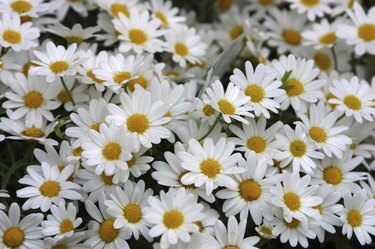
Pollination is the transfer of pollen from the anther of a flower to the stigma of the same or a different flower. The results of pollination, and the pollinators who carry it, are very important to humans and other animals. Without pollinators, flowers like the daisy could go extinct and our diets would include fewer fruits and vegetables.
The Daisy
Video of the Day
The daisy is among the more highly evolved of all the flowering plants. A single flower head on a daisy actually consists of two types of the flowers. The ray flower rings the center disc in flat, broad petals and is sterile; it doesn't produce any pollen. The center disc of a daisy is made up of hundreds of tiny flowers that do produce pollen and nectar. This design is ideal for attracting pollinators. The outer ray flowers offer a stable landing pad for larger pollinators such as butterflies. Additionally, the nectar and pollen in the center disc are easily accessible by any insect. Due to a daisy's fresh, light scent and bright colors, they are most likely to be pollinated by bees and butterflies.
Video of the Day
Butterflies
Butterflies may not be the super pollinators that bees are, but they can be a little more enjoyable to watch. Many are bright colored and intricately patterned. Butterflies are attracted to bright petal colors, red and purple in particular. In fact, butterflies see more wavelengths of color than humans do. The reds, oranges and yellows of many daisies, including the gerbera daisies, are ideal for attracting butterflies.
Bees
While not quite as pretty as butterflies, bees are extremely important as pollinators. Pollination is what they're built for. Bees are covered in fuzzy hairs that help them pick up and carry pollen back to their hives. As they fly from flower to flower, they lose some of the pollen they pick up and pollination occurs. Bees are most attracted to the colors white and yellow, making the ox-eye, or common, daisy a prime bee target.
Protecting Pollinators
Attracting pollinators to your yard or garden with daisies is one thing, but it is important to keep them safe too. Avoid pesticides whenever possible. Use cultural practices to control insect pests such as hosing down plants with water to control small pests or hand picking larger pests. If you have to use insecticides, use safer options such as insecticidal soaps and horticultural oils. Offer sheltered spaces like low ground surrounded by trees for butterflies or logs with holes drilled in them for solitary bees. Provide butterflies with a muddy spot for drinking and leave them rotting fruit for additional nutrition. Plant many different flowers that bloom at different times throughout the year. Asters, for example, are in the daisy family and bloom in the fall.